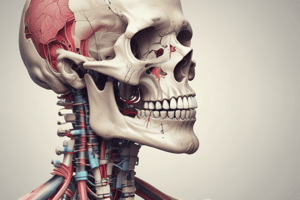Podcast
Questions and Answers
What is the primary function of incisors?
What is the primary function of incisors?
- Grinding and crushing
- Crushing and grinding
- Tearing and piercing
- Cutting and chiseling (correct)
Which of the following is NOT a type of tooth?
Which of the following is NOT a type of tooth?
- Molars
- Cuspid (correct)
- Canines
- Premolars
What is the thin layer covering the root of a tooth?
What is the thin layer covering the root of a tooth?
- Pulp
- Dentin
- Enamel
- Cementum (correct)
Which dental arch is formed by the maxillary bones?
Which dental arch is formed by the maxillary bones?
What is the term for the space between a tooth and the gingiva?
What is the term for the space between a tooth and the gingiva?
What is the cluster of cells that forms dentin?
What is the cluster of cells that forms dentin?
What is the primary function of the periodontal ligament?
What is the primary function of the periodontal ligament?
What is the term for the thick, firm tissue surrounding the roots of teeth?
What is the term for the thick, firm tissue surrounding the roots of teeth?
Flashcards are hidden until you start studying
Study Notes
Teeth
- Types of Teeth:
- Incisors (8): cutting teeth, chisel-shaped, located in front of the mouth
- Canines (4): pointed teeth, used for piercing and tearing, located on either side of incisors
- Premolars (8): used for crushing and tearing, located behind canines
- Molars (8): used for grinding and crushing, located in the back of the mouth
- Wisdom Teeth (4): third molars, located in the back of the mouth, often removed due to overcrowding
- Tooth Structure:
- Enamel: hard, outer layer
- Dentin: softer, inner layer
- Cementum: thin layer covering root
- Pulp: soft tissue inside tooth, containing nerves and blood vessels
- Root: portion of tooth below gum line
- Crown: portion of tooth above gum line
Dental Arch
- Upper Dental Arch:
- Maxillary arch
- Formed by maxillary bones
- Contains upper teeth
- Lower Dental Arch:
- Mandibular arch
- Formed by mandible bone
- Contains lower teeth
Gingiva (Gums)
- Types of Gingiva:
- Marginal gingiva: thin, delicate tissue around tooth margins
- Interdental gingiva: tissue between teeth
- Attached gingiva: thick, firm tissue surrounding roots
- Gingival Sulcus: space between tooth and gingiva
Periodontium
- Components:
- Gingiva (gums)
- Periodontal ligament (PDL): connective tissue between tooth and bone
- Cementum: thin layer covering root
- Alveolar bone: bone surrounding tooth socket
Other Structures
- Dental Papilla: cluster of cells that forms dentin
- Enamel Organ: cluster of cells that forms enamel
- Dental Sac: structure that forms periodontal ligament and cementum
Teeth
- Incisors are 8 chisel-shaped cutting teeth located in the front of the mouth.
- Canines are 4 pointed teeth used for piercing and tearing, located on either side of incisors.
- Premolars are 8 teeth used for crushing and tearing, located behind canines.
- Molars are 8 teeth used for grinding and crushing, located in the back of the mouth.
- Wisdom teeth are 4 third molars located in the back of the mouth, often removed due to overcrowding.
Tooth Structure
- Enamel is the hard, outer layer of the tooth.
- Dentin is the softer, inner layer of the tooth.
- Cementum is a thin layer covering the root.
- Pulp is the soft tissue inside the tooth, containing nerves and blood vessels.
- The root is the portion of the tooth below the gum line.
- The crown is the portion of the tooth above the gum line.
Dental Arch
- The upper dental arch, also known as the maxillary arch, is formed by the maxillary bones and contains the upper teeth.
- The lower dental arch, also known as the mandibular arch, is formed by the mandible bone and contains the lower teeth.
Gingiva (Gums)
- Marginal gingiva is a thin, delicate tissue around tooth margins.
- Interdental gingiva is the tissue between teeth.
- Attached gingiva is a thick, firm tissue surrounding roots.
- The gingival sulcus is the space between the tooth and gingiva.
Periodontium
- The periodontium consists of the gingiva (gums), periodontal ligament (PDL), cementum, and alveolar bone.
- The periodontal ligament (PDL) is the connective tissue between the tooth and bone.
- Cementum is a thin layer covering the root.
- Alveolar bone is the bone surrounding the tooth socket.
Other Structures
- The dental papilla is a cluster of cells that forms dentin.
- The enamel organ is a cluster of cells that forms enamel.
- The dental sac is a structure that forms the periodontal ligament and cementum.
Studying That Suits You
Use AI to generate personalized quizzes and flashcards to suit your learning preferences.



